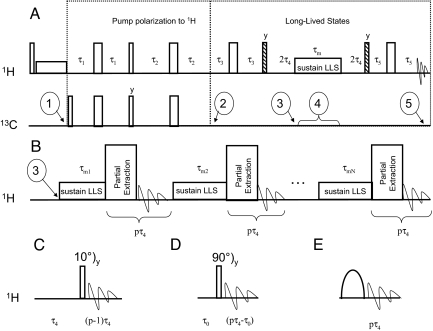Fig. 2.
Conversion of enhanced polarization into long-lived states (LLS). (A) Pulse sequences for the DNP-LLS experiment, used to transfer hyperpolarized natural- abundance 13C magnetization (1) to the CHα2 protons of Gly (2), excite (3), and sustain (4) a LLS on these spins, and transform this into detectable magnetization (5). Hatched, narrow and wide rectangles represent (π/4), (π/2), and π pulses, respectively. The first two proton pulses may be removed for routine applications. The phases are given only when they differ from x. The delays were τ1 = 1/(8J1) = 24 ms, τ2 = 1/(4J1) = 48 ms, τ3 = 5/(4J2) − τ2 = 24.3 ms, τ4 = 1/(4ΔνIS) = 6.7 ms, and τ5 = 1/(4J2) = 14.5 ms, where J1 = J(C′,Hα1,2) = 5.2 Hz, J2 = |J(Hα1,Hα2)| = 17.3 Hz, and ΔνIS = 0.12 ppm = 37.2 Hz at 7 T is the chemical shift difference between the two protons. The interval τm where LLS are sustained ranged from 4 to 25 s. (B) Variant of the (4)–(5) segment of the pulse sequence in A, designed to transform only fractions of LLS into detectable terms, sustaining the remaining part again as LLS. The number p must be a multiple of 4, i.e., pτ4 equals an integer number of precession periods of the zero-quantum coherence. The process may be repeated N times. (C) Method for partial extraction of detectable magnetization from LLC using an interval τ4 = 1/(4ΔνIS) followed by a 10° pulse and detection. (D) Partial extraction of detectable magnetization from LLC using a brief interval τ0 = arcsin(π/18)/(2πΔνIS) ≈ 2 ms, followed by a 90° pulse and detection. (E) Same as C and D, using a selective pulse affecting one of the components of either doublet of the two coupled spins.

